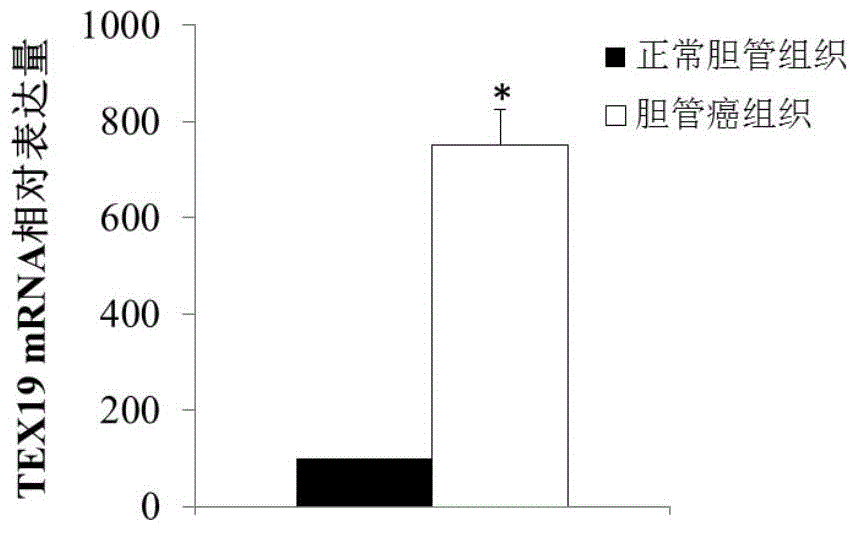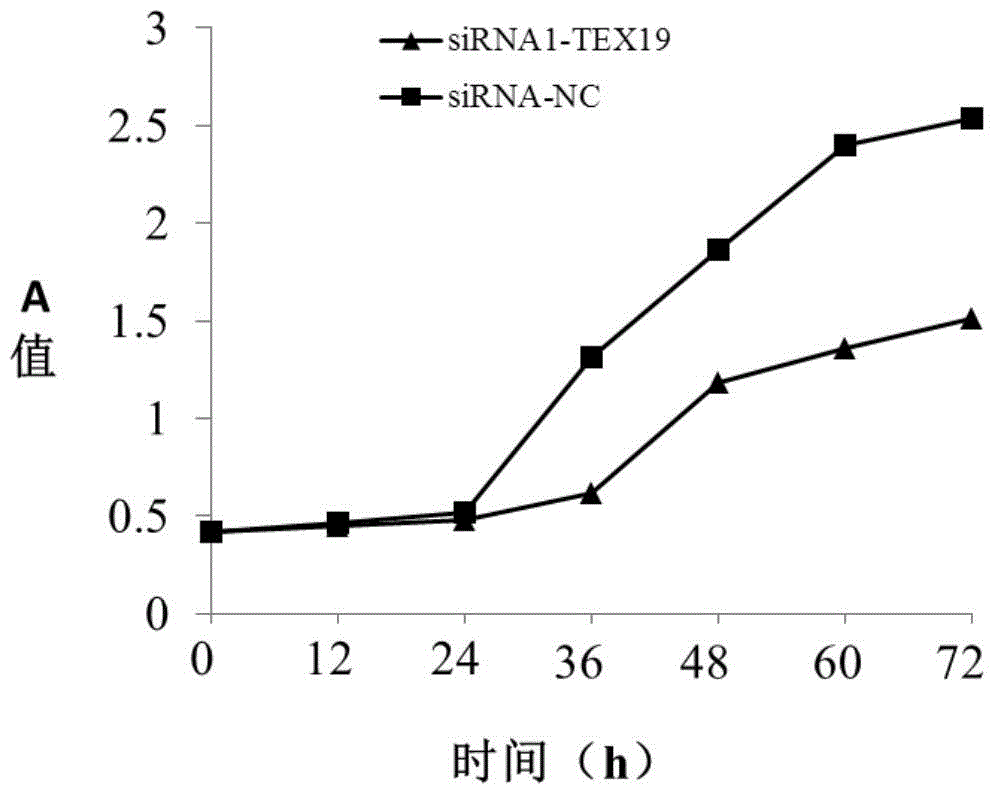Application of TEX19 gene in diagnosis and treatment of biliary duct cancer
A cholangiocarcinoma and gene technology, which can be used in gene therapy, medical preparations containing active ingredients, and antibody medical components, etc., can solve the problems of limited diagnostic methods, low surgical resection and radical cure rates, and lack of diagnostic methods for human cholangiocarcinoma.
- Summary
- Abstract
- Description
- Claims
- Application Information
AI Technical Summary
Problems solved by technology
Method used
Image
Examples
Embodiment 1
[0053] Example 1 Screening for gene markers associated with cholangiocarcinoma
[0054] 1.1 Sample collection
[0055] Eight samples of normal bile duct tissue and cholangiocarcinoma tissue were collected. The above samples are surgical resection specimens of patients with cholangiocarcinoma, and all the above samples were obtained with the consent of the organizational ethics committee.
[0056] 1.2 RNA sample preparation and quality analysis
[0057] 1.2.1 Preparation of RNA samples
[0058] Total RNA in advance using QIAGEN Tissue RNA Extraction Kit. Specific steps are as follows:
[0059] 1) In a clean area with less RNase interference, use a mortar containing an appropriate amount of liquid nitrogen to weigh about 20 mg of the isolated liver cancer tissue sample, and grind it to powder with a pestle;
[0060] 2) Transfer the sample to a RNase-free 2mL centrifuge tube;
[0061] 3) Add 300 μl Lysis solution, place in a homogenizer, and grind thoroughly for 1-5 minutes...
Embodiment 2
[0098] Example 2 RT-PCR sequencing to verify the differential expression of TEX19 gene
[0099] 1. According to the detection results of high-throughput sequencing, the TEX19 gene was selected for large-sample RT-PCR verification. According to the sample collection method in Example 1, 80 cases of cholangiocarcinoma tissue and 80 cases of normal bile duct tissue were selected.
[0100] 2. The RNA extraction steps are the same as in Example 1.
[0101] 3. Reverse transcription: use the reverse transcription kit of TAKARA company to operate. Specific steps are as follows:
[0102] (1) Take 2 μg of total RNA for reverse transcription, add 2 μl of Oligo(dT), and mix well. After 5 minutes in water bath at 70°C, immediately ice bath for 2-3 minutes.
[0103] (2) Construct a 25 μl reaction system, including 5 μl of 5× reverse transcription buffer, 5 μl of dNTP (2.5 mM), 40 U / μl of RNasin, 200 U / μl of M-MLV, and make up to the expected volume with nuclease-free water.
[0104] (3...
Embodiment 3
[0125] Example 3 Inhibition of TEX19 gene expression
[0126] 1. Cell culture: human cholangiocarcinoma cell line QBC939, with DMEM (high glucose) medium containing 10% calf serum at 37°C, 5% CO 2 , Cultivated in an incubator with a relative humidity of 90%. The medium was changed once every 2-3 days, and 0.25% trypsin was used for routine digestion and passage.
[0127] 2. siRNA design
[0128] siRNA sequence against TEX19:
[0129] siRNA1-TEX19:
[0130] The sense strand is 5'-UUGAACUUCUGGAAAUGUCUU-3' (SEQ ID NO.7);
[0131] The antisense strand is 5'-GACAUUUCCAGAAGUUCAAGC-3' (SEQ ID NO.8),
[0132] siRNA2-TEX19:
[0133] The sense strand is 5'-UGUUGAAGCUGAUACAUCCAG-3' (SEQ ID NO.9);
[0134] The antisense strand is 5'-GGAUGUAUCAGCUUCAACAUG-3'(SEQ ID NO.10),
[0135] siRNA3-TEX19:
[0136] The sense strand is 5'-UAACGAUGUUUCUAGAAUGCU-3' (SEQ ID NO.11);
[0137] The antisense strand is 5'-CAUUCUAGAAACAUCGUUAAC-3' (SEQ ID NO.12,
[0138] Negative control siRNA seque...
PUM
 Login to View More
Login to View More Abstract
Description
Claims
Application Information
 Login to View More
Login to View More - R&D
- Intellectual Property
- Life Sciences
- Materials
- Tech Scout
- Unparalleled Data Quality
- Higher Quality Content
- 60% Fewer Hallucinations
Browse by: Latest US Patents, China's latest patents, Technical Efficacy Thesaurus, Application Domain, Technology Topic, Popular Technical Reports.
© 2025 PatSnap. All rights reserved.Legal|Privacy policy|Modern Slavery Act Transparency Statement|Sitemap|About US| Contact US: help@patsnap.com



